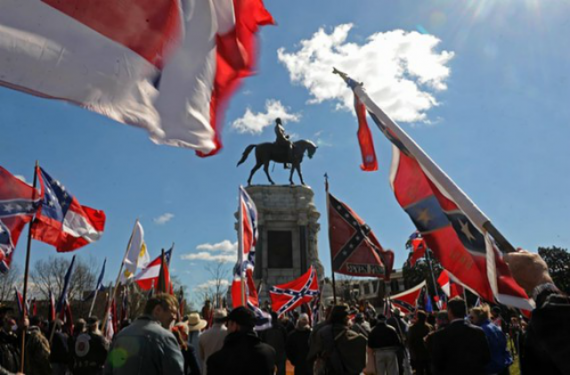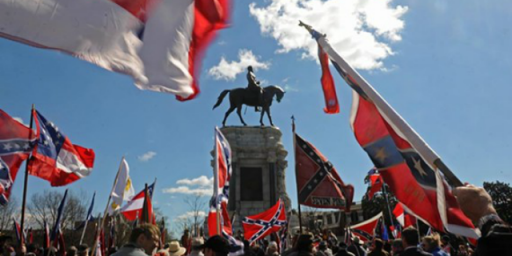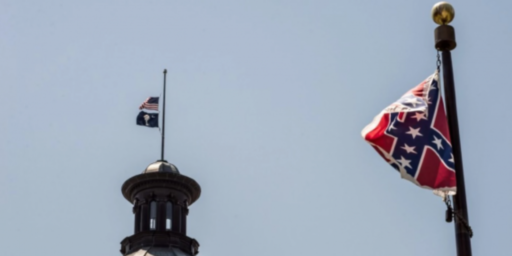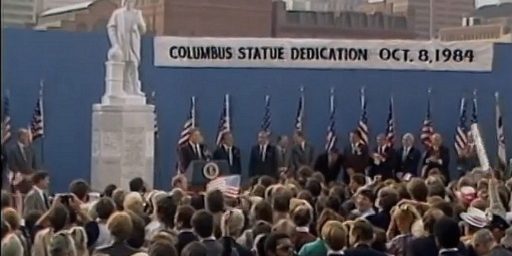Removing Confederate Statues Is Not ‘Erasing History’
The battle over Confederate statues that was resurrected by the violence in Charlottesville is off the front pages, but that doesn't mean it's over quite yet.
While the violence in Charlottesville that occurred in the wake of a rally to “protect” a statute of Robert E. Lee that city officials have since covered with a tarp in anticipation of its eventual removal, the debate over what to do about Confederate memorials and statutes around the South has continued. Most recently, the Dallas City Council voted yesterday to remove a statute dedicate to General Lee from its place of honor in the city and the National Cathedral in Washington, D.C. has decided to remove stained glass depicting Robert E. Lee and Stonewall Jackson. These efforts have been criticized by many on the right, including Vice-President Pence, who argue that removing the statues somehow constitutes an effort to erase history. As The Washington Post’s Paul Waldman notes, however, this argument is an utter fallacy that ignores the reality of what erecting a statute means:
Nobody advocating for the removal of a statue of Robert E. Lee or changing the name of a highway honoring Jefferson Davis believes that we should erase those men from history. Quite the contrary; they should be remembered and understood, for exactly who they were, what they believed and what they fought for.
Defenders of Confederate statues want us to believe not only that a statue is the only way to remember a historical figure, but also that a statue is value-neutral. It’s just “history,” not a commentary on the righteousness of the cause for which those men fought. This, too, is completely ludicrous. We don’t put up statues simply to say “Here’s a thing that happened.” If we did, there would be statues of O.J. Simpson and Balloon Boy. We put up statues to honor, venerate and exalt the people who we are commemorating. There’s no clearer way to say “This person is a hero whose acts we celebrate” than putting up a statue of them.That’s exactly why those statues were erected in the first place: To celebrate the Confederate cause. And they were erected at times when whites in the South were particularly eager to assert white supremacy: most after the end of Reconstruction, with another wave during the civil rights movement of the 1950s and 1960s.
(…)
[I]t’s time for some moral clarity. When someone does something terrible — like fighting a war to maintain slavery — we examine it and explore it and remember it. What we don’t do is celebrate it. We don’t put up a statue of them in the town square. We don’t say to our fellow citizens, “If these men had had their way, you would be a slave today — so we’re going to make you walk by a statue honoring them every day.”
Except we do. And we do it not only because of the poisonous rot within the hearts of some, but also because of the moral cowardice of others, those unwilling to make the simplest of distinctions between right and wrong. If nothing else, they should no longer be allowed to obscure what it is they’re supporting.
Waldman, of course, is absolutely correct. The debate over the removal of Confederate statues and symbols from public lands has nothing to do with ‘erasing history’ or trying to rewrite the history of what the Confederacy or the Civil War were all about. Most if not all of the people arguing for the removal of the statutes, of course, have argued that rather than being put in places of honor these symbols should be placed in places where they can be placed on their proper historical context, such as a museum or a historical park that has been created on the site of one of the many battles during the Civil War that exist everywhere from Gettysburg, Pennsylvania to Vicksburg, Mississippi. If anything, it is those advocating for the removal of these symbols are the ones who are arguing for the removal of the statues are the ones who are arguing for historical accuracy while those who want to keep the statues in place seem to be advocating for a view of history that both fails to properly recognize the context in which the Confederacy existed and the reasons that many of these statues were erected and why Confederate symbols were resurrected during the course of the 20th Century.
On the first point, one need look no further than the statements of the men who founded the Confederacy, such as Confederate Vice-President Alexander Stephens:
The new constitution has put at rest, forever, all the agitating questions relating to our peculiar institution African slavery as it exists amongst us the proper status of the negro in our form of civilization. This was the immediate cause of the late rupture and present revolution. Jefferson in his forecast, had anticipated this, as the “rock upon which the old Union would split.” He was right. What was conjecture with him, is now a realized fact. But whether he fully comprehended the great truth upon which that rock stood and stands, may be doubted. The prevailing ideas entertained by him and most of the leading statesmen at the time of the formation of the old constitution, were that the enslavement of the African was in violation of the laws of nature; that it was wrong in principle, socially, morally, and politically. It was an evil they knew not well how to deal with, but the general opinion of the men of that day was that, somehow or other in the order of Providence, the institution would be evanescent and pass away. This idea, though not incorporated in the constitution, was the prevailing idea at that time. The constitution, it is true, secured every essential guarantee to the institution while it should last, and hence no argument can be justly urged against the constitutional guarantees thus secured, because of the common sentiment of the day. Those ideas, however, were fundamentally wrong. They rested upon the assumption of the equality of races. This was an error. It was a sandy foundation, and the government built upon it fell when the “storm came and the wind blew.”
Our new government is founded upon exactly the opposite idea; its foundations are laid, its corner- stone rests, upon the great truth that the negro is not equal to the white man; that slavery subordination to the superior race is his natural and normal condition. This, our new government, is the first, in the history of the world, based upon this great physical, philosophical, and moral truth. This truth has been slow in the process of its development, like all other truths in the various departments of science. It has been so even amongst us. Many who hear me, perhaps, can recollect well, that this truth was not generally admitted, even within their day. The errors of the past generation still clung to many as late as twenty years ago. Those at the North, who still cling to these errors, with a zeal above knowledge, we justly denominate fanatics. All fanaticism springs from an aberration of the mind from a defect in reasoning. It is a species of insanity. One of the most striking characteristics of insanity, in many instances, is forming correct conclusions from fancied or erroneous premises; so with the anti-slavery fanatics. Their conclusions are right if their premises were. They assume that the negro is equal, and hence conclude that he is entitled to equal privileges and rights with the white man. If their premises were correct, their conclusions would be logical and just but their premise being wrong, their whole argument fails. I recollect once of having heard a gentleman from one of the northern States, of great power and ability, announce in the House of Representatives, with imposing effect, that we of the South would be compelled, ultimately, to yield upon this subject of slavery, that it was as impossible to war successfully against a principle in politics, as it was in physics or mechanics. That the principle would ultimately prevail. That we, in maintaining slavery as it exists with us, were warring against a principle, a principle founded in nature, the principle of the equality of men. The reply I made to him was, that upon his own grounds, we should, ultimately, succeed, and that he and his associates, in this crusade against our institutions, would ultimately fail. The truth announced, that it was as impossible to war successfully against a principle in politics as it was in physics and mechanics, I admitted; but told him that it was he, and those acting with him, who were warring against a principle. They were attempting to make things equal which the Creator had made unequal.
Similar statements can be found in the secession resolutions that were adopted by the Confederate states in their effort to justify their attempt to secede from the union, each one of which cites the desire to promote racial inequality and the existence and expansion of slavery as one of the primary reasons for the action they were taking. The historical record is clear as to what the Confederacy was, and to display their banners or commemorate their leaders and Generals in anything other than a historical context is to give an implicit endorsement to those doctrines the same as if one were to file a Nazi Flag from their window.
As to the second point,the reality is that the statutes came into being for purposes that had nothing to do with properly remembering history, or even honoring the courage of long-dead ancestors. Instead, the purposes were quite venal. Vox’s Zack Beauchamp, for example, points out that these monuments began appearing across the South not in the immediate aftermath of the Civil War, but at those points in the 20th Century that coincided with two events in particular, the revival of the Ku Klux Klan in the early 1910s and the Civil Rights Movement in the 1950s:
It’s not an accident that these statues were mostly built when the South was busy establishing Jim Crow and defending it from the civil rights movement. This is because the purpose of Confederate monuments, as Princeton historian Kevin Kruse argues on Twitter, is not to serve as pure historical markers — but to glorify the Confederate cause. They assert that a war fought on behalf of slavery was a just one, that the people who fought it were morally upright, and that white supremacy should be cherished as part of Southern “heritage.”
That’s why Trump’s equivalency between Confederate statues and one of George Washington misses the mark. Washington was a slave owner, yes, but the meaning of a Washington statue is not necessarily pro-slavery or pro-white supremacy — whereas that’s exactly the point of the vast majority of Confederate memorials in the United States.
Once you understand this point, it becomes obvious why neo-Nazis and white supremacists would rally to the defense of Confederate memorials. The only outstanding question is why the president of the United States would do the same.
In The Washington Post, meanwhile, History Professor Karen Cox expanded on this argument:
Almost none of the monuments were put up right after the Civil War. Some were erected during the civil rights era in the early 1960s, which coincided with the war’s centennial, but the vast majority of monuments date to between 1895 and World War I. They were part of a campaign to paint the Southern cause in the Civil War as just and slavery as a benevolent institution, and their installation came against a backdrop of Jim Crow violence and oppression of African Americans. The monuments were put up as explicit symbols of white supremacy.
The group responsible for the majority of these memorials was the United Daughters of the Confederacy (UDC), the most influential white women’s organization in the South in the late 1800s and early 1900s. Honoring Confederate heroes, generals and soldiers alike, was one of the group’s primary objectives, and the hundreds of monuments throughout the South — and beyond — serve as testimony to the Daughters’ aggressive agenda to vindicate the Confederacy. That lasting power of the mythology they made is still evident today in the raging battles over the fate of the memorials: While Baltimore officials acted quickly to take down four Confederate monuments in that city Tuesday night, laws prevent the removal of such memorials in some of the states that seceded from the Union during the Civil War. Most of those laws were passed only recently, in reaction to calls to remove the monuments or change street names honoring Confederate generals.
The 1890s, when the UDC was founded and monument building began in earnest, represented a decade of virulent racism across the South. Not content to disenfranchise black men, Southern whites went on a lynching spree. Ida B. Wells, the African American journalist and anti-lynching crusader, documented 186 lynchings of black people in 1893 alone — mostly men but women and children, too. As she wrote in her account “The Red Record,” these “scenes of unusual brutality failed to have any visible effect upon the humane sentiments of the people of our land.”
Violence against blacks only increased in the early decades of the 20th century. In addition to continued lynching across the South, the Atlanta Race Riot of 1906 demonstrated how seriously white men took their supremacy over African Americans: An estimated 10,000 white men and boys in the city went after black men, beating dozens to death and injuring hundreds more.
Amid that brutality, the pace of Confederate monument construction increased. The UDC and other like-minded heritage organizations were intent on honoring the Confederate generation, establishing a revisionist history of what they called “The War Between the States.” According to this Lost Cause mythology, the South went to war to defend states’ rights, slavery was essentially a benevolent institution that imparted Christianity to African “savages,” and, while the Confederacy was defeated, theirs was a just cause and those who fought were heroes. The Daughters regarded the Ku Klux Klan, which had been founded to resist Reconstruction, as a heroic organization, necessary to return order to the South. Order, of course, meant the use of violence to subdue newly freed blacks.
(…)
While Confederate monuments did honor their white heroes, they did not always rely on the true history of what took place between 1861 and 1865. Nor was that their intent. Rather, they served to rehabilitate white manhood — not as the losers of a war, but, as the monument in Charlotte, states, preservers of “the Anglo Saxon civilization of the South.”
Today’s defenders of Confederate monuments are either unaware of the historical context or do not care. Like generations of whites before them, they are more invested in the mythology that has attached itself to these sentinels of white supremacy, because it serves their cause.
In other words, the history behind the erection of most of these monuments is almost identical to the history behind the reappearance of the various versions of the Confederate flag, including the familiar one that was utilized by the Army of Northern Virginia. In the immediate years after the Civil War, those flags remained largely confined to places such as battlefield memorials and Confederate cematries, both of which strike me as appropriate places for their display. Just like with the statues, it wasn’t until the early part of the 20th Century and the Civil Rights Era that the flag began appearing in public again. Additionally, it was during the Civil Rights Era that states began to incorporate the design of the flag into their state flaga as part of what came to be called the “Massive Resistance” movement that was born in the wake of the Supreme Court’s decision in Brown v. Board of Education and other assaults on the Jim Crow regime. The intent of the resurgence of the display of the flag, and its incorporation into the state flags of states such as Georgia, Mississippi, and other states was to intimidate African-Americans and others involved in the Civil Rights movement and rally whites around an easily recognizable symbol. In both cases, there was no appeal to heritage, only an appeal to racial hatred.
Whether this is the intention of modern southerners and others who object to the removal of the statues is irrelevant. The fact remains that they honor a past that cannot be glossed over by revering men who do not deserve to be revered, and that they were erected for the purpose of perpetuating an inherently unjust system that sought to effectively maintain a social order that mimicked the institution of slavery and racial oppression upon which the Confederacy was built. Taking the statues down and returning these symbols to their proper places and placing them in the proper context isn’t ‘rewriting history,” it is ensuring that it is being accurately represented. Why anyone would be opposed to that is quite puzzling.






Want a simpler reason why removing monuments isn’t “erasing history”?
– How many statues of Adolf Hitler are there?
– How many people know who Adolf Hitler was?
Like so many issues these days, it’s tribal, not rational. For many, it’s about “libtards” trying to attack their culture and heritage. Or something. Facebook and comment sections are sewers, as usual.
Perhaps, to improve the historical accuracy of the Confederate monuments, the plaques on them should be amended to point out that these men (and women) were traitors to the US of A and the reason for their treason was the continued enslavement of other human beings.
I often get into the discussion on this of “where do you draw the line? What about Jefferson and Washington?” But the thing is … you’ve already drawn a line. No one would tolerate a statue of Hitler or Stalin in a public square. There comes some point at which you say honoring this person is acceptable but honoring that person is not. Some people want to draw the line at Jeff Davis and Robert E Lee; some want to draw it behind them. That’s a debate we should have.
Where’s all the statues of emancipated slaves, African-American soldiers and veterans, and the first black Congressmen in Mississippi and South Carolina and Alabama?
Why are white Southerners so interested in erasing their state history?
As I’ve said before, I favor leaving the monuments in place, but surrounding them with explanatory material that makes it clear why they were erected, and in what context.
Somehow I doubt that the “erasing history!” crowd would find that to be an acceptable way of remembering history.
@Hal_10000:
We’re not going to have that debate because people like Mataconis can’t conceive of their favored historical figures being put under the microscope and haven’t the foggiest notion of how they’d defend Jefferson, Washington and the like from the “but he owned slaves!” argument. They’re just supremely confident it will never get to that point, like they were supremely confident Trump would never be President.
And they’re probably right. After a brief bust of activity and a bunch of white folks patting themselves on the back for finally accomplishing something after their failure to change the name of the Washington Redskins, this whole statue thing will likely fade away because there are about a billion more important things to worry about. So we’ll never have that discussion about how we should put the black and bloody foundations of the United States into context, and certainly no talk at all of how the North sits upon those foundations as much as the South.
And so, the cultural taboo of how we only talk about slavery as a southern thing and ignore all northern connection to it and all the other murderous horrors in U.S. history, like the virtual genocide of the American Indian, will remain in place…at least until it to shatters in another Trumpian shock.
Mike
@MBunge:
Are there any monuments in Virginia to Virginian generals that fought for the Union? No? No holidays dedicated to them like they are to Lee or Jackson? George Thomas and Winfield Scott are just as much historical figures as the other two. This isn’t about history, this is about what we choose to make idols of.
So the reality is that we already had the debate. The racists initially won. Now we get to see how many people want to die on the “defending white supremacy” hill all over again.
I don’t know what context there is to be had. White American culture absorbed Lost Causism in the name national unity (the noble ex confederate soldier as a western frontier hero!). As white people shrink in demographics, the less and less this covenant is tolerated.
On the “preserve history” argument, in one of my favorite towns – Beaufort, SC – there are no statues of Robert Smalls, but his house is preserved as a memorial to a slave who freed himself. For learning history, a visit to his house is worth a dozen statues.
Is it erasing history when a museum takes down a display? I was unaware the Smithsonian trashed everything when a new exhibit comes out.
It’s an incomplete sentence, anyways. Erasing my verison of history what they really mean and in a sense, they are correct. We like to think history is a bunch of facts and dates but as this shows, history’s bias can be quite strong. By taking down the statues/ flags and putting the Confederacy back into the dry, dusty realm of facts and dates robs the myth of power. They need their version out front and proud to keep up the lie that is the Noble Cause. Otherwise their children might ask logical questions like, “If our ancestors seceded, does that mean we’re immigrants from a non-extant nation?” or “How can we claim to be Real Murrica when we claim to be a nation altogether?” My personal fav would be “Daddy, if we never owned slaves like you said, why did Great-great-granddaddy die for rich people who did?”
Little kids say the darnedest things. If you don’t feed them the tripe about how the Confederacy was just really misunderstood, they’ll figure out on their own something not quite kosher with this picture and ask why all these nuts are waving around flags for a country that’s been dead for over a century.
@MBunge:
That is an easy defense. Jefferson and Washington founded the country, they did not lead an army trying to break it up by force. Only an idiot would think that Lee’s statues on public property are coming down because he was a slave owner. Or, somebody who genuinely believes his own supporters are idiots and is trying to confuse the issue.
@KM:
This.
History is history. By raising disloyal murderous insurrectionists that championed and fought to continue slave ownership on a dais, we condone their actions and tell those around us that this is something to which we should aspire.
Is this the message we wish to send today? No.
Is this the message that the Jim Crow / Black Code law supporting states wish to remember? Yes. But that piece of history was the 1920’s – 1960’s, and not a memory of the war itself.
History benefits us all when put into perspective from which we can learn.
As a former Detroiter, at the “The Henry Ford” (formerly Henry Ford Museum and Greenfield Village), much of the 1800’s is preserved for us to revisit. (Long story why it exists, but a fascinating place to visit)
One of the preserved buildings is the Susquehanna Plantation. When the curators decided to add slave quarters onsite, a HIUGE debate ensued. However, history is history, and the buildings were added.
https://www.thehenryford.org/collections-and-research/digital-collections/artifact/268474/#slide=gs-227695
This is the real history of America.
The Germans have openly inspected their actions in WWII, and their memorials are those that honor those victims who have died due to their misguided policies.
We have yet to accomplish this in the USA.
Until we have this national discussion, we will continue to refight what people believe to be their understanding of the 1860’s.
@MBunge:
What’s your hourly rate as a paid Trump troll?
It might help if we actually taught the history of the civil war accurately. Too many children are spoon fed nonsense about the Lost Cause and State’s Rights and slavery is only a footnote.
30 Rock used the Kenneth the Page character to poke fun at this, saying the only thing Georgia schools taught about Lincoln was that he was a gay alcoholic. I used to think this was kind of mean, but after a month of people trying to defend the Confederacy I’m not so sure it was a joke anymore.
Many people on the right complain when they see people with Che Guevara t-shirt. But people that use Che Guevara t-shirts use these t-shirts because they see a revolutionary symbol there. It’s wrong, dumb and misguided, but these people are not openly praising Che Guevara’s murders.
The same thing for Columbus or European kings.
But these Confederate Statues where erected to bully Black People. They are not statues of people that happened to own slaves, they are statues of people that are only there because they owned slaves.
@KM:
“Because he always hoped he’d be rich enough to. And so do I. And so should you because that’s ‘the ‘murkan dream’.”
I’m reminded of the quote attributed to Chairman Mao that history “is written in the voice of the victors.” I don’t particularly like speculating this way, but could it be that part of our national ambivalence to the Lost Cause is that at the time of “the hostilities,” many if not most Northerners in general, including some (significant?) number of abolitionists, only wanted the problem of slavery to go away and had no particular stake in what happened to the slaves? Remember the history of how Liberia came to be–it sounds to this little duck a lot like the attitude of some to the dreamers, “they need to go back to where they’re from.”
@Just ‘nutha ig’nint cracker:
Some years back in the commenting section to Ta-Nehisi Coates’ blog, Yoni Applebaum (who then went by the screen name Cynic) argued that the cliche that “history is written by the victors” (a quote that in one form or another has been attributed to various people but which predates Mao by several decades) is not actually correct, and he went on to cite several examples of when this supposed rule did not apply. The Lost Cause is a prominent example of when this saying does not apply. The losing side in the Civil War greatly shaped the history of the conflict as it’s been presented in schools and popular culture for over a century.
@Just ‘nutha ig’nint cracker:
Oh totally. A different generation phrased their We Done With This Now, Folks thusly: “Our long national nightmare is over”. This is why you hear white nationalists with the gall to claim blacks are ungrateful for all the white blood spilled to free them. The entire attitude reeks of “well what more did you want?” After the Civil War, the nation was eager to get back to status quo. They didn’t want any linger questions on the morality of what happened, what’s going to happen or why. Besides, be an abolitionist didn’t mean you were not racist. They wanted to end the evils of slavery because they saw it as cruel and immoral, not elevate the former slaves to equal status. Liberals frequently attribute more enlightenment to abolitionists then many had; they thought it was the owning and abusing people that was wrong, not necessarily that one race dominating another was a problem as well.
I don’t know if it is history revision, cleansing, or what but something is going on:
“Princeton’s struggle with Woodrow Wilson’s legacy” What’s the deal with Wilson?
CNN host calls for removal of Washington and Jefferson statues
Reverend Al Sharpton says Federal government should stop maintaining Jefferson Memorial.
Hampshire College removal of US flag causes uproar
Manassas cancels Civil War re-enactment camp. These sort of events are educational and present both sides. I fondly remember hearing accounts of Civil War soldiers from both sides holding joint reunions in years long ago. There was no hatred, animosity, or name calling.
Mother of army soldier forced to remove US flag by homeowners association.
We will increasingly see historic figures assailed, and any sort of historic military sites and monuments; including the Vietnam memorial. Misguided individuals will push to have them removed.
I am currently reading a lengthy history of the War of 1812. I also plan to re-read some Civil War books by Bruce Catton and Shelby Foote. I have been combing bookstores and thrift shops buying history books – before they are banned.
“Holocaust? What is that?” – the future.
@Tyrell:
The “deal with Wilson” is his long history of racism and racial bias, and his disdain for civil liberties in general.
He was elected president and led this country during World War 1. But now I guess they will leave out the whole chapter on World War 1 and then the students will wonder if someone miscounted.
It is so ridiculous.
@Tyrell: Can you please just stop being so stupid about this? No one is doing the crap you claim. All you’re doing is ensuring fewer people pay attention to your posts.